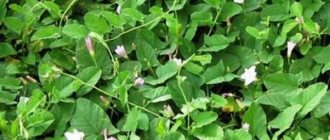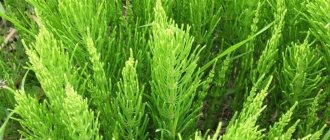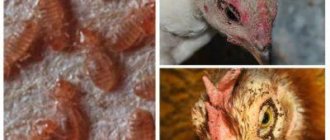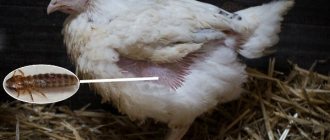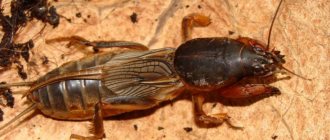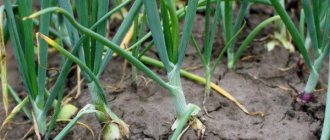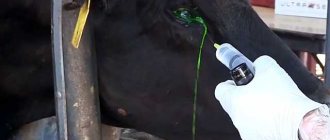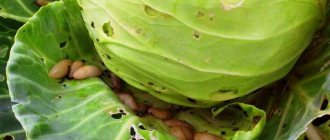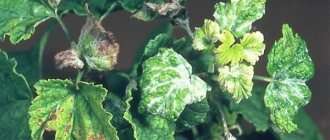Horseradish is a perennial plant that is very famous for its amazing health benefits, but is also known for being very difficult to get rid of because its root system is quite strong and grows deep in the ground. The plant also grows quickly and fills the area. But you can still fight it, and there are a lot of ways, from the most harmless, to those that will allow you to get rid of horseradish forever . In this article we will look in detail at how you can get rid of horseradish in your garden forever.
How to fight horseradish with chemicals
Chemicals - herbicides - will help destroy horseradish in the garden. But remember that their use may negatively affect other crops growing next to the weed. Follow all procedures according to the instructions so as not to lose the harvest. Hurricane, Roundup and Tornado are proven and popular chemicals for getting rid of weeds.
- Roundup is considered the safest. Directions for use: dig up the horseradish roots, make small cuts, take the product into a medical syringe and pour it into the holes. After use, you can plant other crops.
Roundup
- Hurricane is a systemic drug. Directions for use: remove all leaves from the bush, “expose” the root of the plant, make a hole in it, and use a syringe to pour the product concentrate into the prepared “passage.”
Weed Hurricane
- Tornado is a drug that penetrates through the leaves all the way to the root system of horseradish. Method of application: spraying the tops of the bush with herbicide. It is recommended to carry out procedures twice a season.
Tornado
How to cut horseradish correctly
Removing horseradish roots requires patience and care. For this process you will need a pitchfork and a shovel.
The soil in the garden bed is loosened with a rake. After which all the roots, even the smallest ones, are removed. It is important to dig the ground to a depth of 40 cm and a width of 60 cm and carefully monitor the root. It cannot be crushed so as not to stimulate even faster growth of the lateral roots.
In this way, you can weed all the horseradish beds, select the roots and treat the ground with salt, as well as other means.
Use of saltpeter
The effect of saltpeter on the soil
Nitrogen fertilizer - saltpeter - will help remove horseradish from the garden. Throughout the season, pick off the leaves of the plant, preventing it from growing and gaining strength. After mid-summer, towards the end of the season, begin to feed the weed generously with saltpeter, until the first frost. The product will stimulate plant growth, the bush will not be able to prepare for winter and will die. If the weed survives, repeat the procedure the following season.
How to remove horseradish from the garden in the fall
If during the season you did not have time to fight this crop, or you just noticed that it was beginning to grow throughout the entire area, then you can remove it in the fall.
In the summer, try to constantly cut off horseradish leaves. In the fall, we cut off the green mass again, dig up the root and make a hole in it; this can be done with an awl or any other sharp object. Some gardeners insert tubes into the root system.
Through such a hole we pour ammonium nitrate. As a result, the plant will not be ready for wintering and will die during frosts.
In the fall, plant green manure instead of horseradish. They displace almost any crop from the garden. It is best to plant rye, which does not allow the horseradish root system to develop, as a result of which the plant simply dries out.
In order not to look for ways to solve the problem, but you like to use horseradish as a seasoning, then simply plant it in a barrel or any other deep container. A few bushes will be enough for you, and they will not grow throughout the entire dacha area.
Dimming method
The “Dark” method is to prevent sunlight from penetrating the plant. The procedure should begin with the arrival of spring, when it just begins to sprout. To darken you will need a material that will completely prevent light from entering the area where the horseradish grows. It can be roofing felt, slate, black film. Without light, the weed will disappear, and you will not need to use chemicals.
Weed blackout method
Why get rid of horseradish
Horseradish is a perennial herbaceous plant characterized by a powerful branched root system. It multiplies from the slightest segment of the root and begins to grow. That is why horseradish bushes are able to quickly and uncontrollably fill an area, preventing other crops from growing.
Why is it so hard
The powerful root system, growing to a depth of 7 m, makes breeding horseradish a very difficult task . It is almost impossible to pull the entire root out of the ground without breaking it. The remaining parts are tenacious and quickly send out shoots from many buds, which give rise to several new plants at once.
Organics in the fight against horseradish
If you are categorically against the use of chemicals, we recommend using organic substances. An infusion of cow manure, pig or bird droppings, undiluted with water, will help. Instructions:
- Prepare an infusion of mullein or dung, do not dilute it with water.
- Water the plant generously. When the substance is absorbed, the bush will burn out and die completely.
- Make sure that there is no spring of water or cultivated plants near the area where the substances are used.
What to do to prevent horseradish from growing
Horseradish is a useful plant used in cooking to prepare various sauces and seasonings. In folk medicine, horseradish leaves are used in the form of compresses to treat diseases of the joints and spine. The gruel from the root has antimicrobial, antifungal, and anti-inflammatory properties. Seasonings and sauces have a moderate choleretic and diuretic effect. Therefore, horseradish needs to be grown on the plot.
To avoid having to deal with horseradish later, it is planted in a metal or plastic container without a bottom. For this purpose, the container is dug into the ground to the height of the container. Some gardeners make beds fenced with old slate, metal, and plastic. The minimum height of containers and fences dug into the ground should not be less than half a meter. Horseradish planted in this way does not grow in width (remember: young roots grow horizontally).
Once planted in a container, horseradish is dug up the next year, at the same time as it was planted. Having dug up, the small roots should never be thrown onto the compost heap. They should be disposed of off-site or in a trash container. Don't forget, horseradish grows back if you leave even a small piece of it. I hope that these tips will help you get rid of horseradish, as they once helped me.
I wish you good harvests!
Using salt
Using salt to combat horseradish
If none of the remedies work for you, you can use regular table salt. Two ways to use salt when killing horseradish:
- Dig up the roots of the weed, cut the top with leaves, get rid of the tops. Cover the cut with salt and cover with earth.
- As in the first method, dig up the roots, cut the leaves and remove them, and fill the plant with saline solution.
Repeat the procedure several times, but remember that too much salt can ruin the soil.
How to remove horseradish from a plot using vinegar
This method can also be considered a folk remedy. But experienced gardeners note that the method is ineffective. However, I decided to mention it too.
Vinegar not only burns the roots, but also increases the acidity of the soil. Horseradish is an unpretentious crop, but does not tolerate an alkaline environment. Therefore he may die.
But this method is not suitable for an old plant, since the roots go deep underground and feel great there. If nothing helps you, then you can try using table vinegar.
How to get rid of horseradish in the garden, advice from experienced “horseradish haters”
Let's take a closer look at what kind of plant horseradish is? Why can't it be dug up so easily from one place? Bushes sometimes grow so large that they fill the entire area and it becomes unsuitable for growing other vegetables.
- The plant has a very powerful root that goes deep into the ground.
- Horseradish is very tenacious, its roots, imagine the head of the mythical Hydra, you cut off one root, two grow in its place.
- If even one small root remains in the soil, it will definitely germinate.
But it's not that scary. and if you set yourself the goal of getting rid of horseradish in the garden, then everything can be done, of course not at once. You will have to work hard for several seasons. But here it all depends on the degree of neglect of the site.
Methods for removing horseradish
It is quite difficult to combat wild weeds that find themselves in favorable conditions in a cultivated area. Both traditional and modern methods of control sometimes require several years to clear the ridges of overgrown horseradish. But with a systematic fight against horseradish in the garden, the owner of the plot is able to cope with the aggressor.
Digging up rhizomes
The most accessible method is mechanical. Each horseradish bush should be dug up, trying to remove the central powerful root to the greatest possible depth. The lateral roots must be carefully pulled out, being careful not to tear them off. If the bush is large, it is better to remove it in parts, without trying to dig up the entire root at once.
After cutting off the leaves, it is easy to discover that a large plant consists of several bushes connected by a common rhizome. Separate the peripheral shoots and pull out the long lateral rhizomes, helping yourself with a shovel. When there is a relatively small central bush left, it will be easier to dig it up. Before digging, you need to remove a little soil around the base of the horseradish leaves, and then chop the vertically deep central root, plunging the shovel to a full bayonet. A part of this root will remain in the depths, but a new bush can appear only after a few years.
Dug up rhizomes should not be placed on compost heaps. They will not rot, but will remain viable. When you spread organic matter, the horseradish will end up back in the garden. If the burning roots are not needed for culinary or medicinal purposes, they should be taken off site or burned.
Preventing the process of photosynthesis
If the bush grows in an undeveloped area with dense soil and it is difficult to dig it out, you can get rid of the weed using materials that do not transmit light. To fight, you need a sheet of plywood or tin, roofing felt, slate, etc. If the above materials are not available, thick black polyethylene film will do. When applying the method, it must be taken into account that the viability of the plant remains for several years.
Cut off the foliage at soil level so that the shelter fits tightly to the ground. Lay the prepared material in such a way as to cover all shoots and about 20 cm of clean soil around the bush. Press the cover so that it does not move. Leave the weed without access to light for 2-3 years. Deprived of the ability to photosynthesize, horseradish will die.
Replacement by perennial plants
Like any plant, the weed needs sufficient nutrition, soil moisture and sunlight. Even unpretentious plants weaken and die in unfavorable conditions. Perennial shrubs under which there is insufficient light, moisture and nutrition can limit the growth of a bush.
This method of controlling horseradish is only suitable for areas where it is not planned to plant annual garden crops. The place occupied by horseradish can first be cleaned mechanically by digging up part of the bushes, and then planted with ornamental or fruit bushes (currants, gooseberries, lilacs, etc.). Horseradish will disappear within a few years.
Use of salt and nitrate
Traditional methods of weed control involve the use of available aggressive substances: salt and fertilizer. For techniques to be effective, they must be applied correctly:
- Use pruning shears to cut off the leaves from the upper part of the rhizome, where many lateral buds are located (10-20 cm deep);
- for better penetration of caustic substances, it is recommended to cut the remainder of the rhizome crosswise;
- cover the cuts with salt or saltpeter (you need to take 1-2 handfuls of the substance);
- Cover with waterproof material to prevent chemicals from being washed away during rain.
A high concentration of salt or urea prevents the formation of callus on cuts and prevents the development of lateral shoots and the root system.
Herbicides
The modern method of controlling weeds involves the use of systemic and soil-active herbicides. The labeling of the drug must indicate that it is intended to control dicotyledonous weeds. Weed products against horseradish are ineffective.
Processing is carried out according to the instructions for the drug, but there are general recommendations:
- Soil herbicides (Agritox, Estet, Merlin, etc.) are applied to the soil with irrigation water. When using them, you need to know that the absorption of poison will be minimal if the soil under the bush is dry. When using soil poisons, horseradish must be watered with them or toxins must be used during periods of rainfall.
- Systemic poisons (Roundup, Hurricane, etc.) require no precipitation for 3 days after application. These chemicals are applied to the above-ground parts of the weed: sprayed or doused with it. When used in the garden, horseradish must be processed carefully so that drops of the substance do not fall on crops. The drugs penetrate plant cells through the outer integument and act on all tissues. Large weeds may require multiple applications per season.
Additional actions that are often recommended to be taken in the fight against horseradish using herbicides (piercing petioles and roots, syringe administration, etc.) do not increase the effectiveness of the drugs.
Using organics
The use of large amounts of organic fertilizers is based on the content of burning substances in them and increasing the amount of nitrogen in the soil to critical limits. This method is not suitable for combating horseradish, whose roots go deep. Only above-ground parts can be damaged by manure or compost. But a compost heap can be made in the place where the horseradish bush grows: a thick layer of organic matter will limit the access of light and will not allow the weed to grow.
Prevention of overgrowth
In order to have a spice on hand that adds piquancy to home-preserved food, you need to control the spread of horseradish throughout the land. To do this, seeds or a piece of root are planted in a hole, fenced from below and along the perimeter with slate or roofing felt, or in a barrel, which was previously dug into the garden bed and filled with soil.
How to get rid of weeds and grass without chemicals? Weeds harm growing crops in the garden - they reduce the yield, worsen the quality of agricultural...
When safe methods fail, chemicals must be used. The most effective are:
- Tornado - the bush is sprayed entirely, along with the leaves, 3-4 times, in calm weather;
- Roundup - treat the green part by piercing a hole in the stem and pouring the chemical there;
- Hurricane - used only after the surrounding plantings have grown and are securely rooted.
To increase the efficiency of processing, it is recommended to prepare a syringe with a volume of 20 cubic meters without a needle and a thin knitting needle. All leaves are removed from the stem, it is cut as low as possible, many deep holes are made, and a herbicide is injected into each of them. The manipulations are repeated 3-4 times to stop the vital activity of the root. When it dries, be sure to remove the side shoots. If they remain, the fight will have to start again.
Planting
Not the fastest, but effective way to fight it is to displace it from the site by planting pumpkin or zucchini, as well as perennials such as alfalfa and clover.
They grow quickly, begin to take up a lot of space, and take nutrients and moisture for themselves. In such conditions, horseradish withers and gradually dies.
Lawn grass can also displace an aggressive plant. It usually grows densely and over time turns into a smooth carpet.
